

Blyth Hazen, installation view, 2004

Blyth Hazen, "Weight of", clocks and wood, 36"x8"x4", 2004
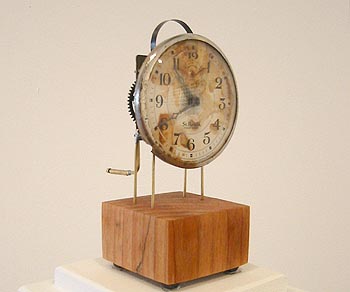
Blyth Hazen, "Haste", clock, brass and wood, 8"x4"x4", 2004
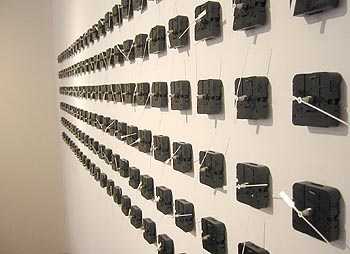
Blyth Hazen, "144", detail, battery operated clocks, 30"x90"x1", 2004
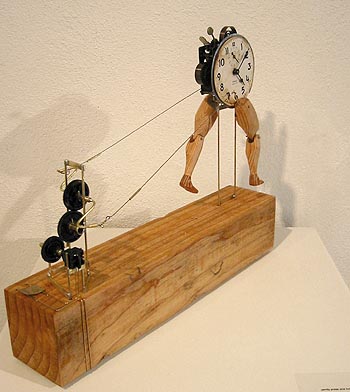
Blyth Hazen, "Walk Clock", wood, brass, clock, motor, 18"x4"x12", 2004

Caroline Bagenal, "Sundial Inscriptions", installation, 2004

www.studiosoto.org
Blyth Hazen and Caroline Bagenal
May 7 - 29, 2004
and 12 hours with
Sarah Smith, Barbara Moody, Julia Purinton, Laura Knott, Mary Behrens, Haig Demarjian, Bert Snow, John McVey, Elissa Della-Piana, Linda Bourke, Jennifer Hall and Christy Park
The history of time keeping is defined by the unyielding pursuit of accuracy and precision. Each technological innovation answered a problem that emerged from an upgrade to a prior system of measurement. Sundials didn't work at night so the solution was the Clepsydra (water clock). A full bucket drained faster than an emptier one giving rise to the pendulum clock. The pendulum didn't work at sea inspiring the wound spring mechanism. Forget to wind? A battery operated quartz watch seemed a very reliable solution. Current atomic clocks measure the 9192631770 oscillations of cesium atom's resonant frequency to determine one second. In 2002 the National Institute of Standards and Technology implemented a cesium clock that is accurate to about 30 billionths of a second per year. We now keep time so precisely that we are out of sync with the motion of the planets.
Once we measured times passage by observing the changing patterns of the stars at night, or by marking the shadows cast by a stick on the ground as the sun progressed across the sky. Now we can purchase watches, clocks, and cell phones that use radio frequencies to constantly synchronize with an international atomic time standard. Do we get the same feeling of awe watching our cell phones automatically switch time zones that we had staring at the sky on a clear night? The works in this collaborative installation are not concerned with the accuracy marking contemporary time keeping, but rather are reflections about measuring, duration and technological progress.
Blyth Hazen's drawings and sculptures take a sidelong look at time-keeping devices. The mechanical tick, swing and chime have been excised from contemporary wall and mantel clocks and replaced with digital approximations. Hazen explores the vanishing nuance of the tic-toc becoming the tic-toc when a pendulum clock hangs crooked on a wall. The works created for this exhibition are early sketches for what will grow into a larger body of work about the ticking, maybe about the passing of time, but most certainly - not about the precision.
Caroline Bagenal based her wall mounted relief texts on inscriptions found on old sundials. These inscriptions allude to philosophical or religious questions, to earth and sun, day and night, light and shadow. They speak about the irreversibility time and the human condition. Thoughts arise of death, of eternity and the preciousness of life. Most were written in Latin, which was the language of early poets, scholars and scientists. The contemporary sundial evolved from early shadow casting instruments of ancient Egypt and China. They were further refined by the Greeks and perfected by Arab mathematicians and astronomers.
This exhibition also included the work of 12 artists invited to create clock portraits. Adding a voice somewhere between the seconds and the stars seemed appropriate to the nature of this project. Each participant was given a 10x10 inch pine block and was assigned one of the 12 hours on a common clock face. No other instructions were provided. Each artist took the challenge in a unique and personal direction.
12 hours
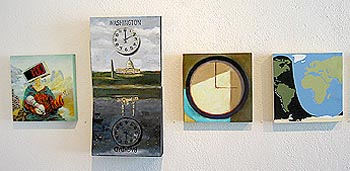
1 o'clock - Sarah Smith, 2 o'clock - Barbara Moody, 3 o'clock - Julia Purinton, 4 o'clock - Laura Knott
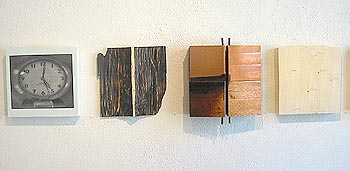
5 o'clock - Mary Behrens, 6 o'clock - Haig Demarjian, 7 o'clock - Bert Snow, 8 o'clock - John McVey
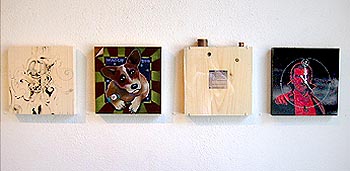
9 o'clock - Elissa Della-Piana, 10 o'clock - Linda Bourke, 11 o'clock - Jennifer Hall, 12 o'clock - Christy Park
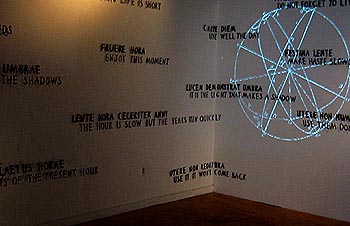
Caroline Bagenal, "Sundial Inscriptions", installation, 2004

Caroline Bagenal, "Sundial Inscriptions", installation, 2004